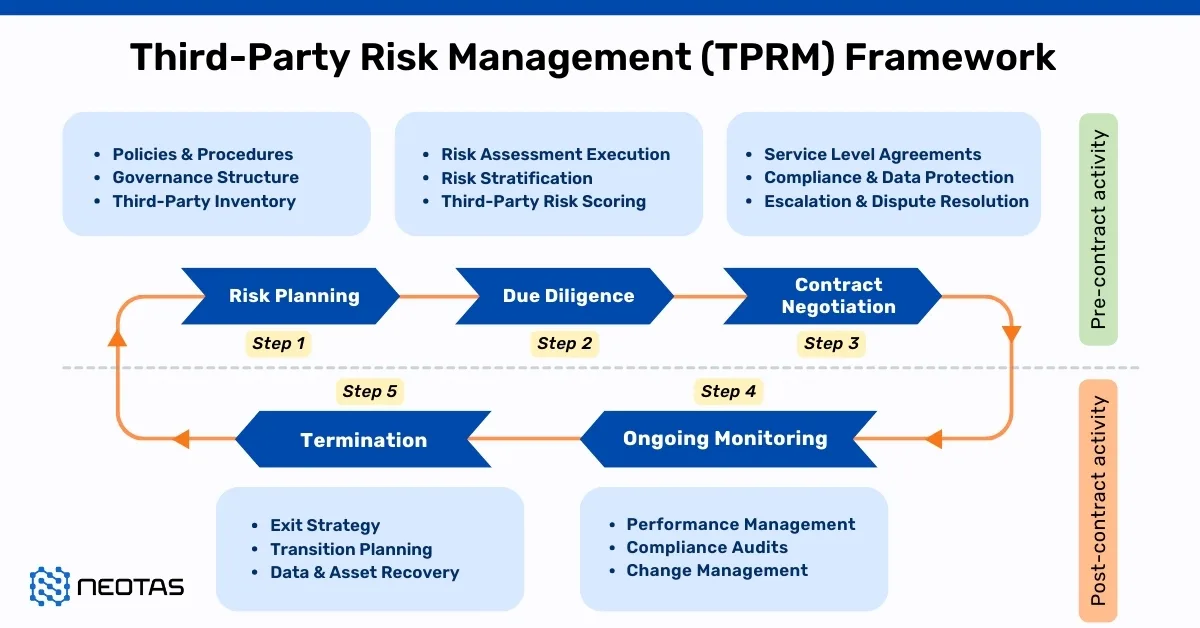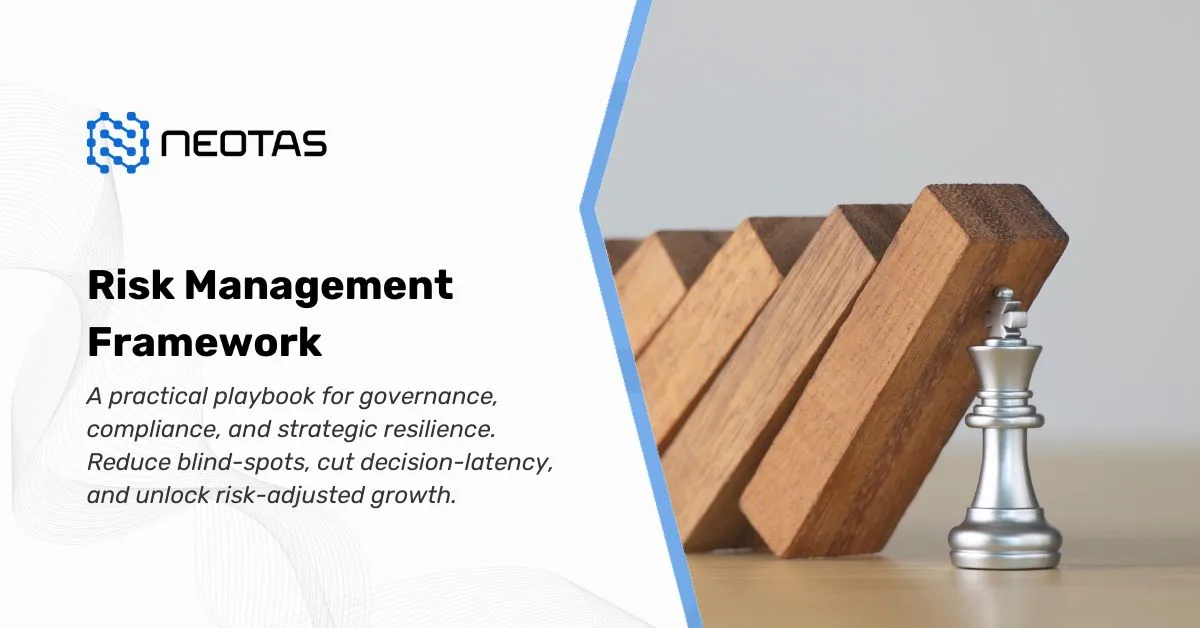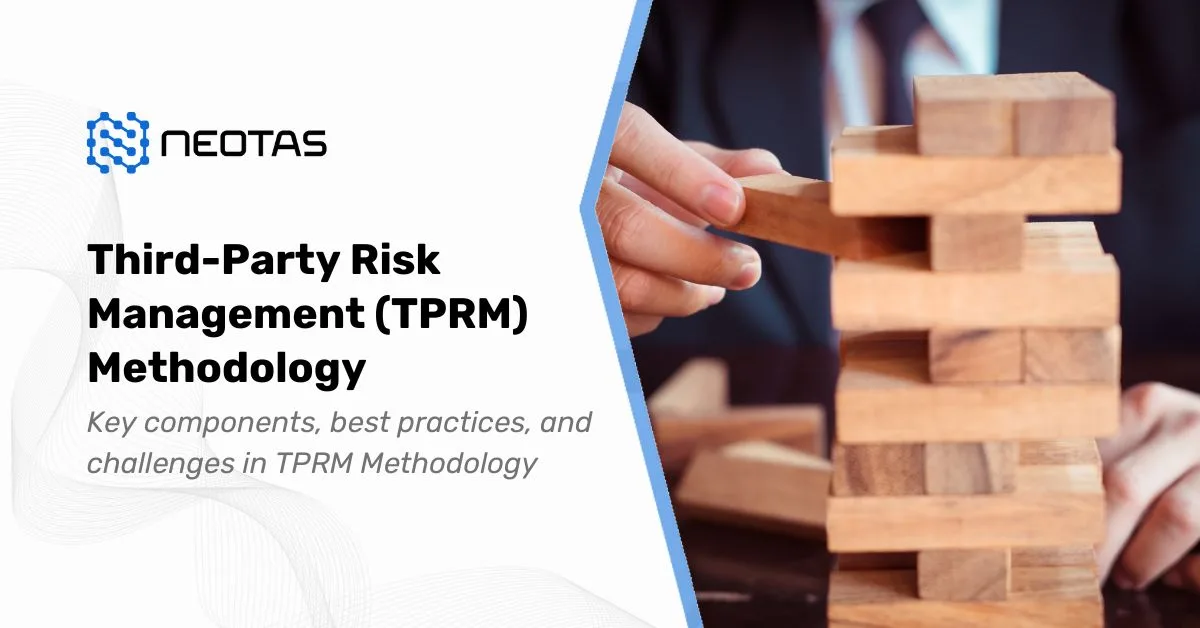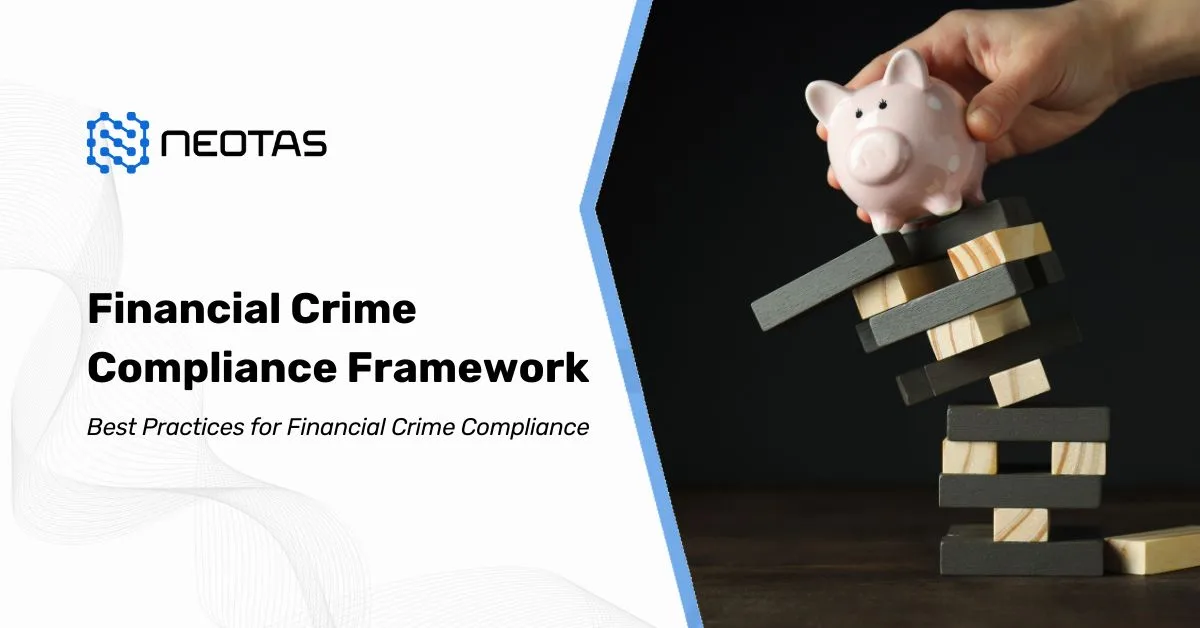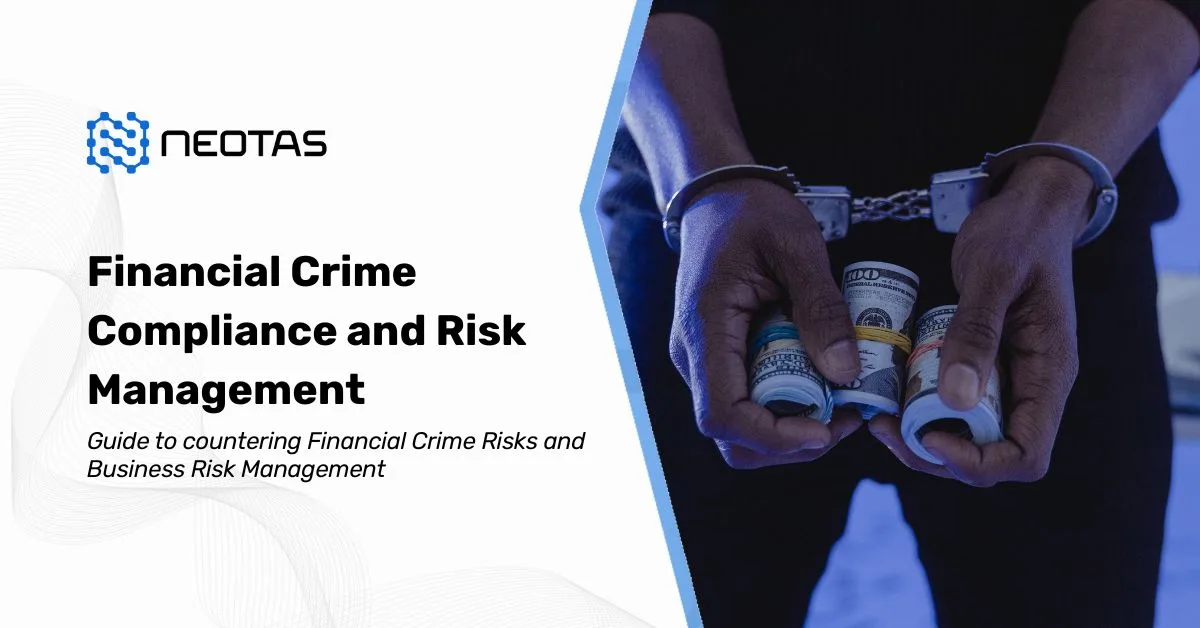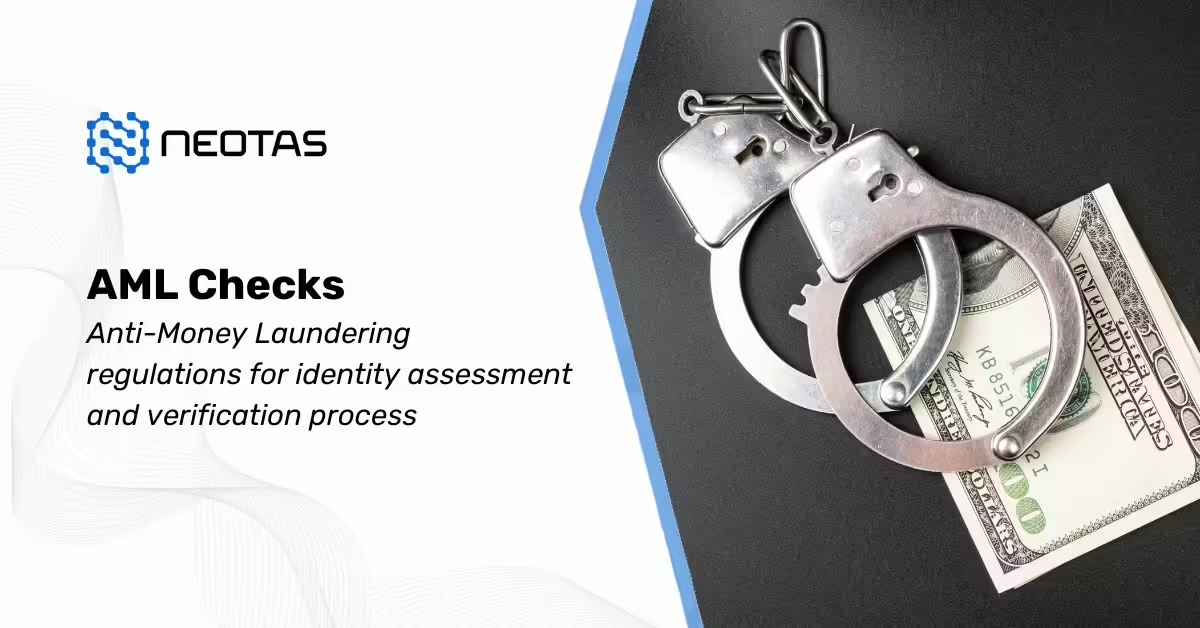What is Simplified Due Diligence?
Simplified Due Diligence (SDD) represents a streamlined approach to due diligence, specifically designed for customers presenting a low risk of money laundering or terrorist financing. It simplifies the verification process, making it efficient for both businesses and low-risk clients.
In this article we will explore:
- The meaning of simplified Due Diligence (SDD).
- The difference between SDD, CDD and EDD.
- Factors compliance teams should consider to select the due diligence process
- Steps Involved in the SDD Process
- Who Qualifies for Simplified Due Diligence?
- When is Simplified Due Diligence needed?
- How to implement simplified due diligence?
Simplified Due Diligence (SDD) Meaning
Simplified Due Diligence (SDD) is a streamlined approach to customer identity verification designed for use in contexts where the risk of money laundering, tax evasion, criminal or terrorist financing, and other financial crimes is considered minimal. As the most basic tier within the Customer Due Diligence (CDD) framework, SDD facilitates a less intrusive vetting process, thereby reducing the burden on both financial institutions and customers deemed to present a low risk.
Simplified Due Diligence (SDD) is a basic identity check for customers considered to have a very low risk of involvement in money laundering, terrorist financing, or other financial crimes. It is specifically designed for situations where the threat of such illegal activities is minimal.
SDD is predicated on the principle of proportionality, whereby the depth and breadth of due diligence measures are aligned with the assessed level of risk. In cases where potential threats of financial impropriety are low, SDD offers an efficient means to fulfil regulatory obligations without the extensive checks characteristic of more comprehensive due diligence procedures. This efficiency is particularly crucial in maintaining the balance between rigorous anti-money laundering (AML) controls and the facilitation of smooth financial transactions for low-risk clients.
The applicability of SDD is determined through a preliminary risk assessment, which considers factors such as the nature of the customer’s business activities, geographical location, and the transparency of their financial transactions. Customers who qualify for SDD typically include those with a clear and straightforward financial profile, for whom extensive verification processes would not proportionately enhance risk management.
It is important to note that SDD is not a one-size-fits-all solution but a component of a tiered due diligence strategy. It stands at the entry-level, preceding Standard Due Diligence (SDD), which applies to low and medium-risk customers, and Enhanced Due Diligence (EDD), reserved for individuals or entities presenting a high risk. This tiered approach ensures that financial institutions can efficiently allocate resources, focusing more intensive investigations on higher-risk profiles while streamlining the process for those less likely to be involved in financial crimes.
Simplified Due Diligence serves as a pragmatic and proportional tool within the broader regulatory framework, aimed at fostering an efficient yet secure financial environment. By judiciously applying SDD, financial institutions can uphold their commitment to preventing financial crimes while ensuring a seamless customer experience for those posing minimal risk.
Simplified Due Diligence (SDD) involves a more straightforward approach to collecting information than more rigorous due diligence levels. However, SDD still adheres to the four essential elements of Customer Due Diligence (CDD) as specified by the Financial Action Task Force (FATF), the international body combating financial crime.
These critical components are:
- Identifying and verifying the customer’s identity,
- Identifying and verifying the identity of beneficial owners,
- Understanding the intended purpose and nature of the business relationship,
- Conducting continuous monitoring of the business relationship.
SDD vs CDD vs EDD
To better understand the workings of simplified due diligence, it’s useful to compare it with standard customer due diligence and enhanced due diligence processes.
Customer Due Diligence (CDD) is an essential process within the financial sector, ensuring institutions understand the risks posed by their clients. This process operates on a continuum, tailored to the level of risk an individual or transaction presents.
Simplified Due Diligence (SDD) is the first level, tailored for low-risk cases. It involves basic checks with a focus on preventing money laundering and terrorism risks.
Moving up the ladder, we have Standard Customer Due Diligence (CDD), which is suitable for average risks. Here, comprehensive checks ensure financial integrity.
Finally, Enhanced Due Diligence (EDD) comes into play for high-risk scenarios. It involves thorough investigations and a broader focus on risk mitigation, including money laundering and terrorism financing.
Each tier is designed to mitigate risks effectively, from money laundering to terrorist financing, ensuring financial integrity.
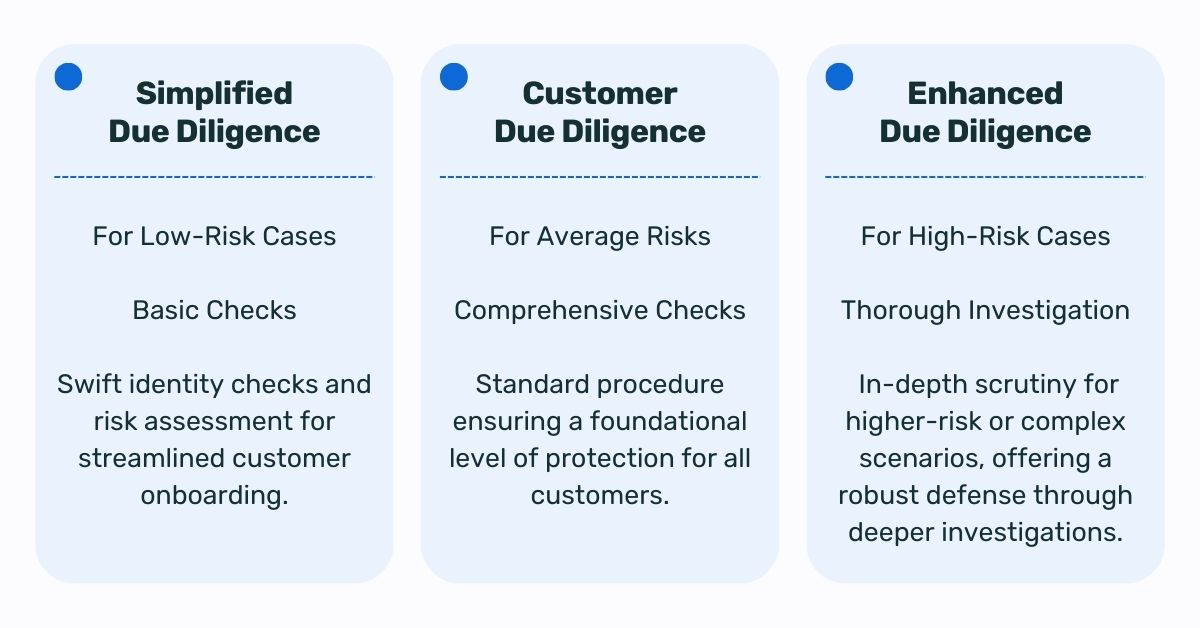
The table below summarises the key differences between SDD, CDD, and EDD:
| Aspect | Simplified Due Diligence (SDD) | Standard Due Diligence (CDD) | Enhanced Due Diligence (EDD) |
|---|---|---|---|
| Customer Type | Low-risk entities | Broad spectrum of customers | High-risk or high-net-worth customers |
| Identification & Verification | Fewer documents, use of public information | Detailed verification process | Extensive verification from various sources |
| Beneficial Ownership | Basic identification without further verification | Thorough examination of ownership structure | In-depth investigation, including intelligence reports on UBOs |
| Politically Exposed Person (PEP) Screening | Limited measures for PEP determination | Standard PEP checks | Intensive screening against PEP and sanctions lists |
| Relatives and Close Associate (RCA) Checks | Not applicable | Not typically required | Mandatory for customers with PEP status |
| Source of Funds (SOF) and Source of Wealth (SOW) Checks | Not applicable | Not standard but may be conducted based on risk | Mandatory verification to ensure legitimacy |
| Adverse Media Screening | Basic adverse media searches to confirm low-risk status | More comprehensive screening | Intensive screening for any negative news |
| Sanctions Screening | Screening against lists to ensure compliance | Standard sanctions and watchlist screening | Rigorous screening, including ongoing monitoring |
| Ongoing Monitoring | Risk-based monitoring of account activity | Regular monitoring to detect changes in risk profile | Intensive and continuous scrutiny of account activity and risk |
Effective CDD is underpinned by a blend of expertise and technology, requiring financial institutions to remain agile as risk profiles and regulatory landscapes evolve. While SDD offers a less resource-intensive approach, it’s crucial that systems are in place to dynamically update customer profiles, ensuring that the level of due diligence applied remains appropriate to the risk presented.
Factors compliance teams should consider to select the due diligence process
When determining the appropriate level of due diligence, particularly Simplified Due Diligence (SDD) the following shall be assessed:
- Customer Type: The nature of the customer plays a significant role. Low-risk customer types are more likely candidates for SDD.
- Jurisdiction: The location or jurisdiction in which the customer operates can impact the risk level. Some jurisdictions may pose higher risks than others.
- Occupation: The customer’s occupation or industry matters. Certain industries may inherently have lower or higher risks.
- Products and Services Offered: The specific products or services offered by the customer can influence the risk assessment. Some products or services may be associated with higher risks.
- Account Type: The type of account being opened or the financial service being provided is a critical factor. Different accounts may carry different levels of risk.
- Ownership Structure: Understanding the ownership structure of the customer can provide insights into potential risks. Complex ownership structures may warrant more thorough due diligence.
By evaluating these factors comprehensively, compliance teams can make informed decisions regarding the application of Simplified Due Diligence (SDD) and ensure that the appropriate level of due diligence aligns with the risk profile of the customer or entity.
What are the Steps Involved in the SDD Process?
The Simplified Due Diligence (SDD) process, applied in low-risk scenarios within the financial sector, involves a series of streamlined steps designed to ascertain the identity and assess the risk profile of customers, without the exhaustive checks required for higher risk categories. Here is an overview of the key steps involved in the SDD process:
- Initial Risk Assessment:
- The process begins with an initial assessment to determine whether a customer or transaction qualifies as low-risk. This assessment is based on predefined criteria such as the type of customer, nature of transactions, business relationship, and geographical location.
- Collection of Basic Identity Information:
- Basic information to establish the customer’s identity is collected. This typically includes name, date of birth, address, and national identification number. For corporate entities, this may involve gathering information on the nature of the business, registration details, and principal owners.
- Verification of Identity:
- The collected information is then verified using reliable, independent sources. This could include checking against public databases, electoral registers, or other publicly accessible records. The verification process in SDD is less exhaustive compared to Standard or Enhanced Due Diligence.
- Assessment of Beneficial Ownership:
- For corporate clients, a basic understanding of the ownership structure is obtained to identify the beneficial owners. Unlike in Enhanced Due Diligence (EDD), there is no requirement for in-depth verification of the owners’ identities unless there is a change in risk perception.
- Purpose and Intended Nature of the Business Relationship:
- A clear understanding of the purpose and intended nature of the business relationship is established to ensure it aligns with what would be expected from someone with a low-risk profile.
- Conducting PEP Screening (If Applicable):
- While SDD may limit the extent of Politically Exposed Persons (PEP) screening, a basic check is often conducted to ensure the customer does not hold a prominent public function that could elevate their risk profile.
- Ongoing Monitoring:
- Accounts under SDD are subject to ongoing monitoring, albeit at a frequency and depth that reflect their low-risk nature. This involves keeping an eye on transactions and any significant changes in the customer’s status or business activities that might affect their risk classification.
- Record-Keeping:
- Financial institutions are required to keep records of the SDD measures applied, including the information obtained during the identity verification process and the rationale for classifying a customer as low-risk.
It’s important to note that while SDD involves fewer and less detailed checks, financial institutions must remain vigilant for any indications that a customer’s risk level may have changed, necessitating a reevaluation and potentially more rigorous due diligence measures.
Who Qualifies for Simplified Due Diligence?
While initial identity checks and verification are standard for all new customers, only a subset will meet the criteria for Simplified Due Diligence (SDD) based on their low risk for money laundering (ML) and terrorist financing (TF).
Typically, SDD is suited for:
- Financial Institutions: Those regulated under anti-money laundering statutes, such as the European Union’s Anti-Money Laundering Directives (AMLDs), due to their compliance obligations and oversight.
- Regulated Entities: Organizations accountable to community institutions, with established checks and balances, ensuring transparent operations and financial dealings.
- Public Authorities: Bodies with publicly disclosed identities and transparent accounting practices, reducing the opacity that often accompanies financial crimes.
- Specific Financial Products: Providers of certain insurance policies, electronic money products, or pensions, where the nature of the product limits the risk of ML/TF.
However, the applicability of SDD can vary significantly across jurisdictions. For instance, the Fourth Anti-Money Laundering Directive (4AMLD) in the EU mandates that firms must not rely on predefined lists of low-risk customers for automatic SDD application. Instead, they must actively assess and justify the low-risk status of each customer before applying SDD measures.
In Canada, the Financial Transactions and Reports Analysis Centre of Canada (FINTRAC) allows a “simplified identification method” for seven specified entity types, contingent upon firms documenting their rationale for deeming these entities low-risk for ML/TF.
Contrastingly, New Zealand’s Anti-Money Laundering and Countering Financing of Terrorism Act 2009 delineates 19 customer types eligible for SDD, showcasing a more prescriptive approach.
These variations highlight the importance of understanding and adhering to local regulatory frameworks when implementing SDD. Financial institutions must not only identify customers eligible for SDD but also maintain a robust process for continually assessing and documenting the risk profiles of their customers, ensuring compliance with evolving legal standards and practices.
When is Simplified Due Diligence Needed?
It is designed for situations where the risk of money laundering or terrorist financing is assessed as low. This streamlined process allows for a more efficient verification and monitoring of clients, thereby optimising resource allocation within compliance departments.
SDD becomes necessary under several specific circumstances:
- Establishing Business Relationships: When a financial institution initiates a new business relationship, it must assess the risk profile of the prospective client. If this risk is deemed low, based on predefined criteria such as the nature of the business, geographical location, and the transparency of transactions, SDD may be applied.
- Low-Risk Transactions: Transactions that fall below a certain threshold, which is often defined by regulatory bodies, may qualify for SDD. These are typically low-value transactions that do not exhibit characteristics commonly associated with money laundering or terrorist financing.
- Regulated Entities: Entities that are already subject to regulatory oversight and compliance checks, such as banks and other financial institutions within the European Union that adhere to Anti-Money Laundering Directives (AMLDs), may qualify for SDD. This is because their regulated status provides a certain level of assurance regarding their risk profiles.
- Public Bodies and Authorities: Public authorities or state-owned enterprises, known for their transparency and lower risk profiles due to public accountability and regulatory oversight, are often eligible for SDD.
- Low-Risk Financial Products: Certain financial products, like specific insurance policies, pensions, or electronic money products that have limitations on their use or withdrawal, might qualify for SDD due to their inherent lower risk of being used for money laundering or terrorist financing.
- Customer Risk Profile Changes: If ongoing monitoring reveals that a customer’s risk profile has decreased and is now considered low risk, SDD procedures might be applied moving forward.
It is imperative to note that the applicability and criteria for SDD can vary significantly across jurisdictions. Financial institutions must navigate a complex landscape of international, regional, and local regulations that dictate when SDD can be employed. For example, the Fourth Anti-Money Laundering Directive (4AMLD) in the EU stipulates that financial institutions must actively demonstrate the low risk of their customers to apply SDD, moving away from a pre-defined list of eligible entities and individuals.
Moreover, the adoption of SDD must be accompanied by rigorous documentation and justification processes to ensure compliance with regulatory standards. Financial institutions must maintain records of the rationale behind deeming a customer or transaction as low risk and applying SDD. This includes documenting the customer’s business activities, source of funds, and any other relevant information that supports the low-risk assessment.
Its application is guided by a thorough assessment of risk, underpinned by a deep understanding of the customer and the nature of the business relationship. As regulatory landscapes evolve, so too must the strategies employed by financial institutions to implement SDD effectively, always ensuring that the measures taken are proportionate to the risks identified.
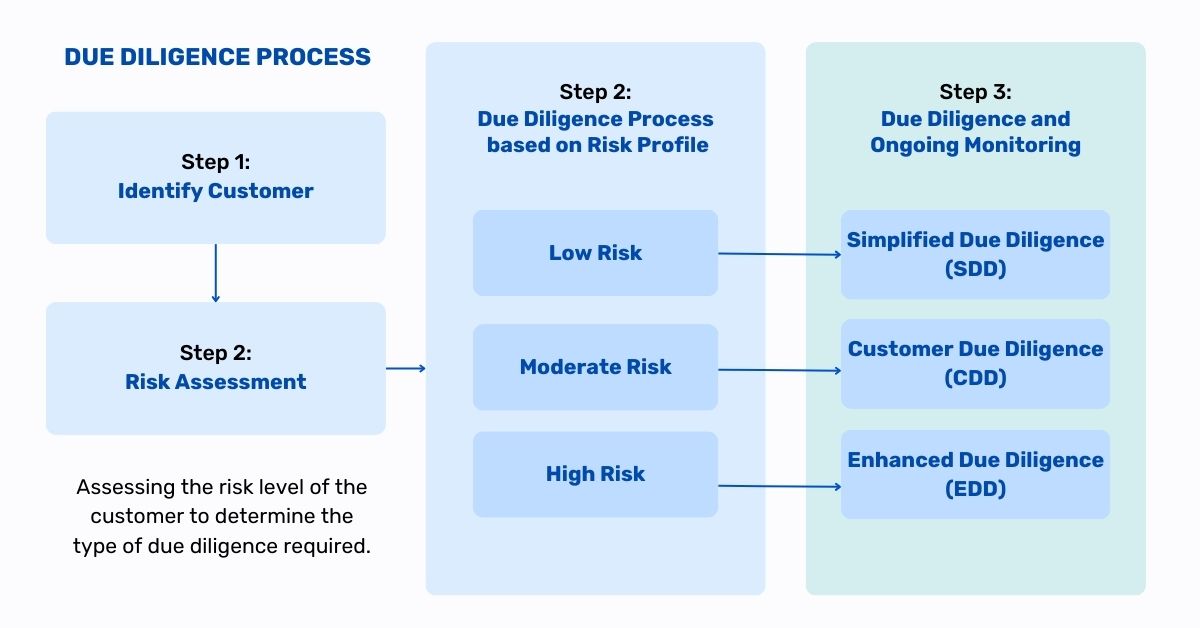
How to implement simplified due diligence?
Implementing Simplified Due Diligence (SDD) effectively within your business requires a nuanced approach, particularly with the integration of flexible identity verification solutions that can adapt the Customer Due Diligence (CDD) process to the assessed risk levels. SDD is reserved for low-risk scenarios, offering a less intensive method to gather and verify customer information compared to standard or enhanced due diligence processes.
For effective implementation, your business should consider the following steps:
- Obtaining Identifying Information: Initiate the customer identification process (CIP) as part of the onboarding procedure, ensuring that the collected data is accurate to mitigate risks associated with false identities.
- Determining the Level of Due Diligence: After verifying the customer’s identity, assess the appropriate level of due diligence required based on various factors such as customer type, occupation, ownership structure, and the offered products or services.
- Proceeding With the Chosen Type of Due Diligence: If a customer is identified as low-risk, proceed with a simplified and less detailed identity verification process. This might involve using public information or fewer documents for verification purposes.
- Conducting Ongoing Monitoring: Even after the customer has been onboarded, it’s essential to continuously monitor their activities to ensure they remain low-risk. Any suspicious activity may warrant a transition to more rigorous due diligence measures.
To streamline the SDD process and make it scalable, leveraging automation and advanced technology like artificial intelligence is advisable. Automation can facilitate rapid processing of customer data, including facial recognition for biometric verification, automated risk assessment, and real-time transaction monitoring, enhancing both efficiency and customer satisfaction while ensuring regulatory compliance.
Implementing SDD requires a strategic blend of understanding regulatory frameworks, assessing customer risk profiles accurately, and employing technology to automate and simplify the process. By adopting these practices, businesses can ensure compliance with AML regulations without compromising on operational efficiency or customer experience.
About Neotas Due Diligence
Neotas Platform covers 600Bn+ archived web pages, 1.8Bn+ court records, 198M+ corporate records, global social media platforms, and 40,000+ Media sources from over 100 countries to help you build a comprehensive picture of the team. It’s a world-first, searching beyond Google. Neotas’ diligence uncovers illicit activities, reducing financial and reputational risk.
Due Diligence Solutions:
- Enhanced Due Diligence
- Management Due Diligence
- Customer Due Diligence
- Third Party Risk Management
- Open Source Intelligence (OSINT)
- Introducing the Neotas Enhanced Due Diligence Platform
Due Diligence Case Studies:
- Case Study: OSINT for EDD & AML Compliance
- Overcoming EDD Challenges on High Risk Customers
- Neotas Open Source Intelligence (OSINT) based AML Solution sees beneath the surface
- ESG Risks Uncovered In Investigation For Global Private Equity Firm
- Management Due Diligence Reveals Abusive CEO
- Ongoing Monitoring Protects Credit Against Subsidiary Threat
- AML Compliance and Fraud Detection – How to Spot a Money Launderer and Prevent It


 What is Simplified Due Diligence: understand SDD vs CDD vs EDD, who needs SDD, checklist, & the steps involved in Simplified Due Diligence process. Neotas UK.
What is Simplified Due Diligence: understand SDD vs CDD vs EDD, who needs SDD, checklist, & the steps involved in Simplified Due Diligence process. Neotas UK.
 New Whitepaper and Checklist
New Whitepaper and Checklist